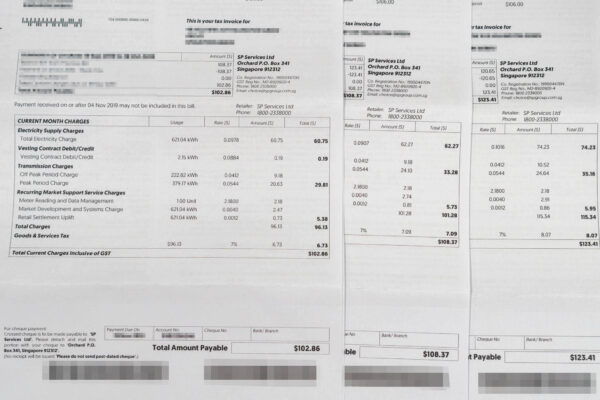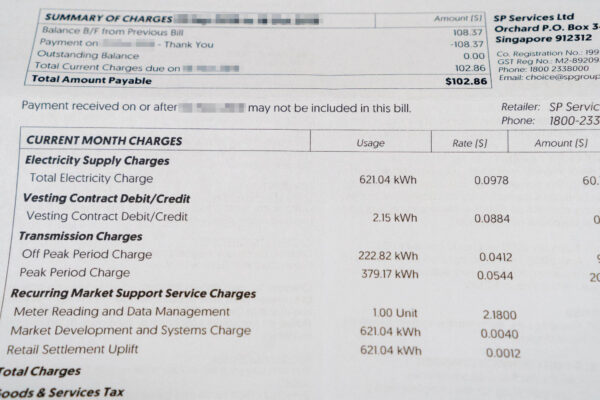
It’s been just a little over a year since retail electricity became available to residential consumers. I originally signed up with Geneco on a short six-month contract, then decided to quit and return to SP Services, not on their regulated tariff plan, but on their wholesale plan. It seems to be working out.
Prior to last November, apart from a limited Open Electricity Market trial, residential consumers had to buy their electricity from SP Services on a regulated tariff basis. When the electricity opened up, we saw that prices from the retail electricity sellers were lower than the regulated tariff. I suppose that is to be expected, otherwise residential electricity consumers would simply stick with SP Services.
Something that many residential electricity consumers might not know is that SP Services had an alternative option to the regulated tariff plan. They do have a wholesale electricity plan for the small customers like us.
SP Services’ Wholesale electricity plan means you get charged the wholesale electricity rate, the same rate (in principle) at which retailers get their electricity. This rate fluctuates on a half-hourly basis. At the simplest level, this is about supply and demand.
The actual wholesale electricity rate is very little, typically something like under 10 cents per kWh. Contrast this to the present 23.43 cents per kWh (excluding GST). I know this sounds extremely good, but that’s now the whole story. Wholesale electricity comes with a lot of other price components that you need to pay separately. These are:
- Vesting Contract Debit/Credit: Variable
- Transmission charges: two different rates, 4.12 cents per kWh for off-peak hours and 5.44 cents per kWh for peak hours
- Meter Reading and Data Management charge: $2.18 per meter
- Market Development and Systems charge: 0.4 cents per kWh
- Retail Settlement Uplift: 0.12 cents per kWh
All the components above, except for the first one (i.e. Vesting Contract Debit/Credit), are rates that are known up-front. Like the regulated tariff, the price may change from time to time, but the rates are published beforehand.
The Vesting Contract Debit/Credit component is variable, and the amount is not known until after you have consumed electricity. Vesting Contracts are bilateral agreements between power generation companies and the Market Support Services Licensee (presently SP Services) that mandate a specified amount of electricity to be hedged at a specified price. This is done in order to mitigate against larger power generation companies influencing market prices by withholding supplies.
For consumers new to wholesale electricity plans, this unknown Vesting Contract Debit/Credit component can be rather worrisome. The component, however, is small. It works out to be under 20 cents per month. Sometimes it can be zero.

How has my electricity prices been like while on this wholesale electricity plan? Well, everything in, I average about 16 cents per kWh, inclusive of GST.
You don’t get it cheaper from any other electricity retailer.
Of course, in the big picture, you may also want to compare the incentives offered by electricity retailers in the Open Electricity Market, such as discounts, bonuses when you recommend friends, or rebates from bundling other services, etc.
SP Services’ wholesale electricity plan is standalone, and they are disallowed by the energy market regulator from bundling services or offering promotions. The good thing, however, is that there is no contract. You are always free to change any time.
The wholesale electricity plan has offered me the best value every month. I may be disadvantaged if some day wholesale market prices skyrocket, compared to having been riding on a long-term contract that had been locked to a very low price. I’m betting this is unlikely to happen, and even if so, I could still switch retailers, though granted new contract prices won’t be as cheap as before if present market trend is going upward.
Wholesale electricity being priced every half-hourly also has the advantage that you can plan your high electricity consumption during low price periods. You won’t know the prices up front, but you do get a forecast indication from the Energy Market Company’s Price Information webpage. Do note that forecast prices are not finalised; the final price settlement comes about a week or so later.
If you’re interested to get on this wholesale electricity plan, here’s what you need to do:
- If you are still on the regulated tariff, just head to SP Utilities Portal and look for the option to switch to the wholesale electricity plan.
- If you are already on one of the electricity retailers in the Open Electricity Market, you need to tell your present retailer that you want to quit and return to SP Services’ wholesale electricity plan. It took me quite a long while to quit Geneco (almost a month), so be prepared to plan your exit ahead of time.
Even if not required, it is best to get the new smart meters (Advanced Metering Infrastructure), which records your electricity consumption in real time. This allows SP Services to bill you according to your actual half-hourly consumption. Otherwise, you will be billed based on a presumed national consumption profile, which may work for or against you.
(Note: In the bill sample above, for simplicity, SP Services simply shows a single kWh rate for the electricity charge. With a smart meter, the true half-hourly consumption information can be downloaded from SP Utilities Portal.)
Update: How Is Wholesale Electricity Doing? (25 Sep 2021)
Appreciate your sharing the experience very much. What is the average /kwh charge for Nov, any idea?
For the bill in Nov, mine works out to 15.366 cents per kWh (including GST).
Also, would love to hear more about your school life at ACS and whether, if you were to do it over, would you still go to ACS and send your kids there? Would ACS be suited for a kid from a poor family? Is there a challenge for a poor kid to keep up with the Joneses with gadgets and spending?
With the electricity tariff hikes from Jan-Mar 2020 do you still see the benefits in opting for SP wholesale? I’m considering between SP wholesale and a fixed 12 or 24 month contract and the deeper I research the more confused I become. It’s so hard to find reviews or people even talking about SP wholesale, thank you for writing this!
Well, I don’t have 2020 bills yet. The last bill is Dec 2019, and my net electricity rate is 14.22 cents per kWh (inclusive of GST). It’s a surprising big dip from Nov. I think with retail plans, the retailers basically earn a margin from the assurance they give you for the fixed prices (or fixed discount rate). They need to earn after all, they are simply go-between. Going SP Wholesale certainly has risks, but so far despite spikes from time to time, they work out much cheaper overall. Also, do remember you can always quit any time since SP Wholesale is contract-free. Hence, the only thing to worry is that you may “miss out” on a fabulous super-long term ludicrously low fixed price plan when electricity prices have skyrocketed. 🙂
Yes, you have a point, guess I’ll go with SP wholesale too! Thanks for replying 🙂
Hi Zit Seng,
I can’t find the option in the SP Utilities page. However, I’m currently signed with Ohm energy with no contract. Would it appear after I switch back or it the option gone?
You won’t see the option when you’re with Ohm. You need to call Ohm to say you want to quit and return to SP Services on their wholesale electricity plan.
It looks like from your past results, even if there is a possible raise in rates, it may not even go beyond $0.175+ pricing, which is what most retailers are charging.
You’re right. So far it’s been looking good.
Do you receive an email each month to tell you that your Wholesale electricity bill is generated and a reminder to make payment?
Yes, you get a bill like how it has always been with SP Services in the past. Oddly enough, because left, and then returned, my electricity is on a new account different from gas and water, so I have two separate bills.
I had read this blog post when it was published but did nothing. While reading your post on the masks issue, saw the link to jump to here. Now I am convinced to switch to SP wholesale market thanks to you.
Hi Zit Seng, thank you so much for this really helpful information. Quoting your article above “Otherwise, you will be billed based on a presumed national consumption profile, which may work for or against you”, may I ask where can I find further info about what the national consumption profile is like?
Also, both my wife and myself work from home therefore I think our peak hour consumption during the daytime will be alot more than sleeping time but given the fact that we don’t have smart meter installed not sure if this national consumption profile will work for us or not.
I thought I had seen a load profile published somewhere before, but I can’t seem to locate that right now. The best I can find now is https://www.ema.gov.sg/Metering_Options.aspx.
Thank you so much! This is helpful!
Hi Zit Seng, do have to read the meter yourself or SP meter reader does it?
Thanks You
The smart meters are read remotely. That’s how we can get half-hourly readings and almost in real-time (about half-day delay).
but how about an existing old meter, I don’t think it a smart meter or needs to install one if switch to SP wholesale electricity?
Hi Zit Seng, do you have to read the meter or th SP meter reader does it?
Thanks You
Double posting, blog owner please delete it, sorry
hi, thank you. it’s very informative. can you also do an updated review, in light of the increased electricity tariffs announced recently?